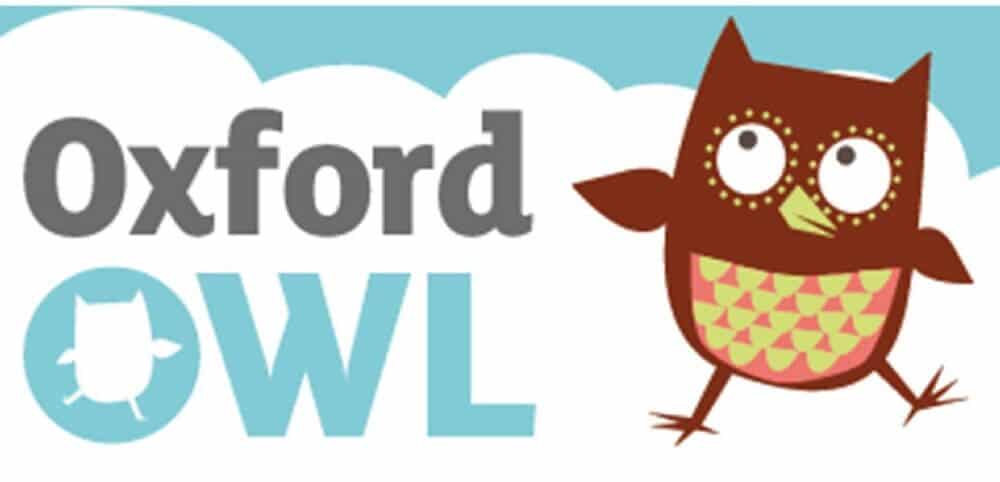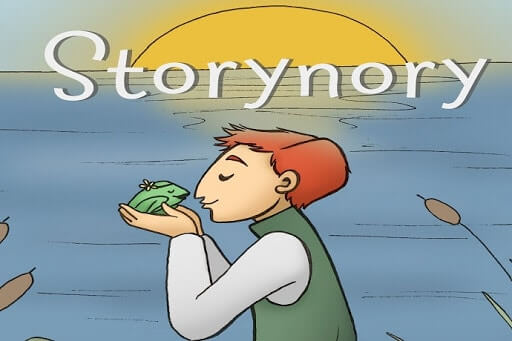Reading in English is one of the best ways to build your child’s vocabulary. It can also be a good family activity to do together. The websites below will give you free resources to help make reading with your child fun, as well as educational. Let’s take a look!

Why should you read in English with your child?
Childhood is the best time to start learning a second language. A positive early experience with English often leads to a better connection with the language and improved fluency in later life. For kids, speaking and listening are easier skills to develop than reading and writing. However, learning to read in English from a young age will help your child to develop a wider vocabulary and a better understanding of structure (grammar).
Children’s books are written and illustrated to be fun, engaging and easy to understand. Connecting a new piece of vocabulary or grammar to a story or poem can make it easier for a child to remember. Reading interesting stories doesn’t feel like hard work or “study” so this is good preparation for more formal English lessons later.
Reading together with your child can help them take more of an interest in it. If they struggle to read by themselves, then listening to you read a story in English will still help them to practise their listening skills and build their vocabulary. You might even find a new favourite story together!
The recommended websites below are a mix of British and American resources. Most include videos or audiobooks, which you can use with your child to practise listening and matching the sounds of words to how they are written. All of these kids’ reading websites are free to access and many of them offer downloadable ebooks!
This is a superb website for reading online because instead of giving you an ebook, its stories are in the form of interactive games! The story appears onscreen at the same time as it is read aloud, and you can interact with the story while it is being told. There are also bonus games to play afterwards, song videos, and printable activities. The site is built for young children, including pre-schoolers who are just learning their letters for the first time. New stories are added to this website regularly.
Each interactive story comes with at least one game, two songs, and a printable activity sheet to help your child practise new vocabulary that they have learnt during the story.
Try the Preschool Activity Library to find stories and activities based around your child’s interests – for example: colours, trains or their favourite animal! You can also look into the Literacy page for top tips on “raising a reader”!
We Enjoyed: I Will Not Take A Bath is a very funny little story about a baby who doesn’t want a bath until he has his favourite toys – why not practise telling the story with your child’s favourite bath-time toys?
Suggested Age Range: 3-6 years
Starfall is an online resource build to help children learn to read. It offers interactive books for preschool children and young schoolchildren, each book is built around practicing particular letters and sounds. There are also seasonal stories – such as Pumpkin for Halloween or Snowman for Christmas – and simple maths exercises in English!
There are also lots of free resources for teaching your child at home, including printable worksheets, flashcards and posters. Some resources are only available to teachers in the USA and Canada, but there is more than enough material for you to use when teaching your kids English at home!
Try the Talking Library to practise reading and listening to famous stories – or even learn a bit of Shakespeare! Make sure you check out the Parent-Teacher Center for printables, advice, and even lesson plans!
We Enjoyed: The It’s Fun to Read section has some fun tongue-twisters to try! How fast can you say them all?
Suggested Age Range: 3-9 years

Oxford Owl is a British website providing free ebooks, learning activities, and workbooks for children. You have to sign up to the site to gain full access, but creating an account is completely free and gives you access to a library of hundreds of books and structured learning resources! Sounds good, right?
All resources are categorised by age, making it easy to find stories that should interest your child. Activities and workbooks are also divided in this way, making it very easy to navigate what’s best for your son or daughter!
Try the phonics guide, which is written to help parents understand and teach English phonics to their children! If you want to practise writing as well as reading with your child, the Activity Books section includes a workbook for proper handwriting. This is especially useful if your native language doesn’t use the Roman alphabet!
We Enjoyed: The Winnie the Witch books are a fun series of stories about an inept witch, and have a lot of lively illustrations that are great for younger children to explore and talk about!
Suggested Age Range: 4-11 years
Storyline Online is a great site for finding free videos of writers, teachers and sometimes celebrities reading children’s storybooks aloud. The videos come with fun visuals from the story as well! Each video also has free activity guides for both teachers and parents. These will give you plenty of ideas on how to discuss the story with your child, and games you can play afterwards.
The website’s blog also contains links to many other useful resources. Storyline is run by the award-winning SAG-AFTRA Foundation, and they are linked to a huge network of excellent literacy resources for children!
Try listening to a story one day, and then the next day too, watching it again with the sound off and the captions on. See if your child can imitate how the reader of the story talks! Don’t forget to look at the Activity Guides below each video to find ways to get your child thinking about the story they have just heard.
We Enjoyed: Library Lion is a cute, funny story that teaches children about how to behave politely in a library and the importance of helping other people.
Suggested age range: 3-12 years
This one is, quite simply, exactly what it says on the tin – a website dedicated to sharing children’s books for free! Books are sorted for toddlers, young children, older children and young adults/teenagers, and can all be either read online or downloaded as a pdf for offline reading.
As well as storybooks, this site has hundreds of non-fiction books, allowing your child to use English as a tool to learn about different countries, famous people, history, science, or whatever takes their fancy!
Try the School Textbooks category to find free textbooks and workbooks aimed both at American schoolchildren and kids studying English as a second language. The Learn to Read category is also an excellent stop if your child is just beginning to learn to read in English – it’s full of books that are simple, but engaging!
We Enjoyed: Sticky Brains by Nicole Libin is a great book for learning how to talk about emotions, as well as good and bad events. It is an easy way for kids to learn about managing stress in life.
Suggested Age Range: 3-15 years
The ICDL is an incredible resource for finding children’s books from all around the world. Most of the books are in English, but there are dozens of languages available. There are many books that are in more than one language, like the award-winning The Blue Sky by Andrea Petrlik Huseinović, which you can read in English, German, Italian, Spanish, Russian, Slovak, Romanian or Farsi! The website is easy to explore and gives you access to hundreds of books that you can read online for free!
Books are sorted by language, but also by country. You can decide whether you’d like to read books in English from America, Australia or Great Britain – just as we have different accents, you might notice some differences in how we write and tell stories!
Try finding some books that are available in both your native language and English. Read them together in your native language first, then read them together in English! Look for the White Ravens tag as well – these are top quality books that have been approved by a panel of language specialists!
We enjoyed: The Hare of Inaba, a translation of a famous Japanese fairy tale in English, German, Italian and Spanish. The story is short and easy to read and comes with many beautiful Japanese paintings!
Suggested Age Range: 5-12 years
Project Gutenberg is the world’s best resource for finding books for free online. Most of the books are older books, but there are still plenty of children’s books that can be read online or downloaded to read on your phone, tablet or kindle. Make sure to check the publication date of a book before using it because some of them are hundreds of years old and the English in them doesn’t look anything like modern English!
Project Gutenberg adds books to its library when they come into the public domain, so they add hundreds of new books every January 1st. It’s a particularly useful site for teenagers who are interested in history!
Try reading different versions of a famous story, like Cinderella or Goldilocks and the Three Bears, and see what new words you can learn from different books! Make sure to use the Bookshelves feature to make it easy to find the kind of books you’re looking for, such as “Children’s Picture Books”!
We enjoyed: The Blue Fairy Book is a very pretty e-book with nearly forty famous stories that are easy to read quickly!
Suggested age range: 5+ years
Breaking News English is a website that updates every day with news articles written in English at different fluency levels, ranked from 0 to 6. The articles written at levels 0-3 should be interesting to children, but the higher levels are excellent practise for teenagers and adults, too!
Each article comes with several activities attached, with different activities for each level. The goal of these tasks is to encourage children to think and talk about the news that they’ve just read and to help your child take an interest in what’s happening in the world!
When looking for articles, try picking a Theme that interests your child – e.g. the environment or technology. Older learners can look at articles focused around education and even business!
We enjoyed: Using the listening section to hear articles read aloud. You can listen to them at different speeds to make it easier or more challenging. You can also listen to them in either American or British English so you can get used to different accents!
Suggested Age Range: 6+ years

Storynory is an excellent site with stories aimed at older children, teenagers, and even adults. Above the text of each story is an audio recording, so you can listen to it as you read. Hundreds of stories, poems and non-fiction books are accessible completely free!
Storynory also contains a sizeable library of poems, rhymes and music. Children have an easier time learning rhymes and songs because they have a rhythm. Practising some of the classics available on the site can really help your child remember new vocabulary too!
Try reading the comments that people have left under each story and decide if you agree or disagree. Once you’ve read a story, leave your own comment saying what you think of it! The Junior Stories section contains short stories for younger children, and while it’s not very big right now, the collection is growing fast!
We Enjoyed: The Histories of Herodotus have been written in easy English, so your child can learn some history in a fun and engaging way!
Suggested Age Range: 8+ years
Wikipedia is one of the most useful sites on the internet for learning new things, but you can also use it to help your kids learn English! Simple English Wikipedia rewrites wikipedia articles to make them easier to read, which can be very useful when you’re learning English as a second language.
This website is not the best resource for absolute beginners. However, it can be very helpful for anybody with a couple of years’ experience reading in English who wants to expand their general knowledge and their reading ability.
Try reading about your own country or your child’s favourite movie and see if you can learn something new together! Alternatively, set your child a project to do on a particular subject and show them how to use wikipedia to research their topic online. This is a useful skill to learn.
We enjoyed: The page on Basic English includes a picture wordlist, which is a great resource for learning core English vocabulary and making your own flashcards at home!
Suggested age range: 10+ years